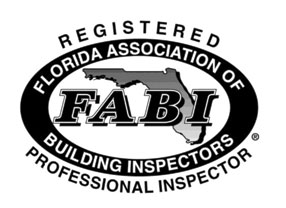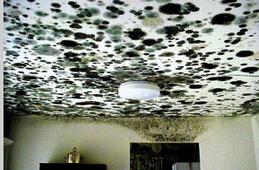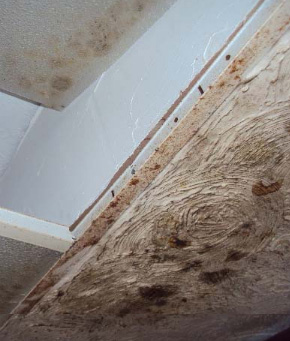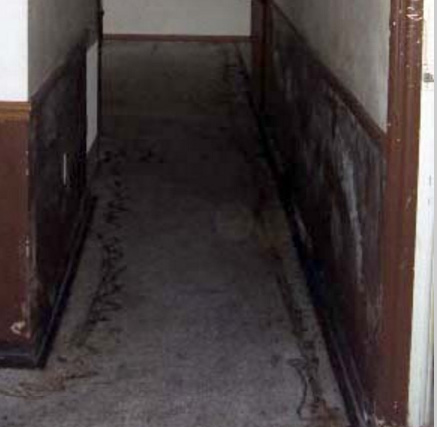What is Mold and Where Is It Found?
Mold are microscopic organisms that
produce spores and are found virtually
everywhere, both in indoors and outdoors
. Mold can be found on plants, foods, dry
leaves, and other organic material. Also
susceptible to mold growth are cellulose
materials, such as, cardboard, paper,
ceiling tiles, and sheet rock. Mold spores
are easily detached and made airborne by vacuuming, walking on a carpet or sitting on a couch. In indoor environments, mold can grow in air conditioning ducts, carpets, and pots of houseplants, etc.
How Can Mold Affect Your Health?
Exposure to mold is not healthy for anyone but the following individuals are at a higher risk for adverse health effects such as: Infants, children, elderly, immune compromised patients, pregnant women, and individuals with existing respiratory conditions. When inhaled, even in small amounts, mold can cause a wide range of health problems including respiratory problems (wheezing), nasal and sinus congestion, watery and red eyes, nose and throat irritation, skin irritation, aches and pains, fevers, asthma, emphysema and in some most extreme cases even death.
Mold Can Be Found In Many Areas Of Your Home
Attic
Living Rooms
Bathrooms
(HVAC) Ventilation System
Bedrooms
Kitchens
Basements
Any Moist Areas
Carpets
Garage
How Can You Be Exposed To Mold?
When moldy materials become damaged or disturbed, spores (reproductive bodies similar to seeds) can be released into the air. The following are sources of indoor moisture that may cause mold problems in your home or office: Flooding, leaky roofs, humidifiers, damp basements or crawl spaces, constant plumbing leaks, house plants, steam from cooking, shower/bath steam and leaks, wet clothes, and clothes dryers vented indoors.
“The Black Mold” Stachybotrys Chartarum (atra)
Stachybotrys Chartarum (atra) is a type of mold thought to be a possible cause of the “Sick Building Syndrome.” Stachybotrys is a greenish-black toxic mold that colonizes particularly well in high-cellulose material, such as straw, hay, wet leaves, dry wall, carpet, wall paper, fiber-board, ceiling tiles, thermal insulation, etc. Stachbotrys, before drying, is wet and slightly slimy to touch. There are about 15 species of Stachybotrys, known throughout the world. This toxic mold grows in areas where the relative humidity is above 55%. This type of mold does not grow on plastic, vinyl, concrete products, or ceramic tiles. It is not found in the green mold on bread or the black mold on the shower tiles. Stachybotrys produces a mycotoxic that causes human mycotoxicosis.
Children's exposure to Stachybotrys spores are thought most likely to cause pulmonary hemosiderosis (bleeding in the lungs). The following is a list of symptoms associated with exposure to Stachybotrys mold spores:
Respiratory problems, such as wheezing, and difficulty in breathing
Nasal and sinus congestion
Eyes-burning, watery, reddened, blurry vision, light sensitivity
Dry, hacking cough
Sore throat
Nose and throat irritation
Shortness of breath
Chronic fatigue
Skin irritation
Central nervous system problems
(constant headaches, memory problems, and mood changes)
Aches and pains
Possible fever
Diarrhea
Possible hemosiderosis
Immune suppression
Protection...Testing Is Your First Line Of Defense
To help determine if the air quality is a concern in your home or office, you may want to consider an air sampling test be performed. Using the latest air quality testing equipment, KGI will collect and forward the air samples to a certified testing laboratory that uses patented analytical methods for accuracy and reliability. The laboratory testing results will determine the species and the levels of the spores in the air. Under guidelines set by the State we are not permitted to dismantle or remove items to determine the extent of any mold growth in concealed areas. The State recommends a State licensed and insured Remediation Company to set up a protocol after the correct containment has taken place in the dismantling process to determine the extent of any concerned growth.
Helpful Links Regarding Mold
Wind Mitigation | Chinese Drywall | Mold | Testimonials | Contact Us
P.O. Box 174, Ellenton, FL 34222 | 941.776.3903
WE ARE A PROUD BUSINESS AFFILIATE



